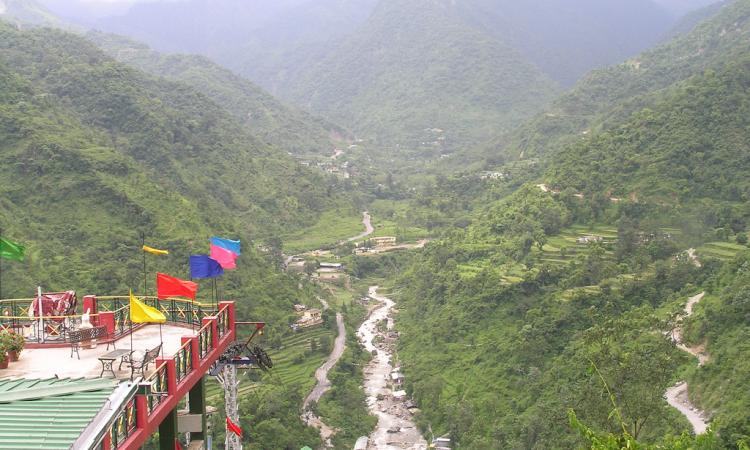
Govind Ram has seen the worst and best that man can do to nature. A resident of Kharawa village near Dehradun, the 42-year-old was part of both the destruction and renewal of the hills that form a distinct part of his life. Govind’s village falls in the catchment area of Sahastradhara--literally meaning a thousand springs--a famous tourist spot around 15 km from Dehradun. The place is so named because it is surrounded by mountains full of caves formed due to the erosion of limestone rocks by water. Large hollow cavities have formed over millions of years as the water continues to drip through cave roofs. Sahastradhara is also the source of sulphur springs, which also attract tourists from across the country. An old Shiv temple and a cave believed to be used for meditation by Guru Dronacharya, the teacher of Pandavas and Kauravas in the epic Mahabharat, provide spiritual essence to the place.
.
Impact of mining
Important streams including the Song, Baldi, Rispana, Kairuli and Bhitarli originate from the limestone belt of Mussoorie and Dehradun's hills nourishing thousands of acres. Countless springs act as drinking water sources of the mountain villages. However, the area lost its appeal in the 1960s when limestone mining became widespread with as many as 105 mines in operation.
The Sahastradhara region was particularly affected as committees set up by the Union government and the Supreme Court to assess the ecological damage found the mines operating in this area to be among the worst. Felling of trees for laying down roads and excavation of hills disrupted the ecological cycle. Loss of trees not only led to recurrent landslides but also adversely impacted the vast underground aquifers. Debris rolled down the hills to block the irrigation channels.
“Flow of water was substantially reduced. While quarrying operations badly impacted the pastures and fodder base of the village, blockage of irrigation channels led to a drastic reduction in food production", says Govind who, as a teenager, worked at the mining sites. The debris coming down also raised the bed of the Baldi stream thus resulting in submergence of nearby farms. The villagers, who had earlier welcomed mining expecting employment opportunities, realised that their traditionally reliable source of livelihood was under threat.
The Dehradun-based Rural Litigation and Entitlement Kendra wrote to the Supreme Court of India highlighting the ecological damage. The court treated the letter as a writ petition and after detailed examination of the impact, ordered closure of the mines in 1985. However, the area had degraded to such an extent that it required rehabilitation measures. In the absence of vegetation cover, large amounts of debris and boulders eroded down to the road which also hampered accessibility of the visitors. The situation worsened in the rainy season when roads remained blocked for about 4 months and the Public Works Department was forced to spend Rs 1.5 lakh every year for maintenance and operation of the roads.
The rejuvenation
The Indian Institute of Soil and Water Conservation took up the task of reviving the region through different interventions including planting trees, constructing loose boulder check dams, gabion structures, trenches, geo-jute and Katta crates to check soil erosion. The local villagers were involved in implementing social measures like ban on open grazing in the area to ensure that the plantations reach optimum levels etc. Villagers like Govind also worked on the site during the rejuvenation process weaving wire boxes for gabion structures, digging out trenches to check run-off and soil erosion, and planting saplings.
“At that time, the vegetation cover in the area was around 5 percent which has now reached more than 95 percent with species like acacia catechu, biuns, narcul, kachnar and guava besides napier grass which is an important fodder for the livestock", says Surender Sharma of the Institute. Very soon the results of the interventions became apparent--more water began seeping down the soil which meant more water in the springs even in the scorching months of April and May.
Earlier, the area had very little income generation opportunities. There was only one water mill and the majority of the locals had to migrate outside the village for employment. With a ban on mining and the rejuvenation of the Sahastradhara micro watershed, the number of tourists increased.
How it sustains
Today, the area has more than 100 shops including eateries, tea stalls, and general stores. An amusement park with entertainment facilities and a ropeway have also been established. Generation of local self-employment opportunities has drastically reduced out-migration from the region.
Govind, who is also running a dhaba now, thanks the rehabilitation of the badly-spoiled mined area for a dramatic change in his standard of living. “Earlier, I was not able to earn more than Rs 500-600 per month as a wage labourer. Today, the income is Rs 8,000-10,000. Due to increased availability of green fodder, we have also increased the number of livestock and my wife sells surplus milk in the market which provides additional income", he says.
Sahastradhara holds a mirror to those who believe that setting up of big industries through reckless destruction of environment is the only way forward. Given the right impetus, nature can give us plenty for a longer term too.
Vishal Gupta works with Natural Resource Management Group of the Dehradun-based People’s Science Institute
Image Source: Dr Umesh Behari Mathur/ Flickr